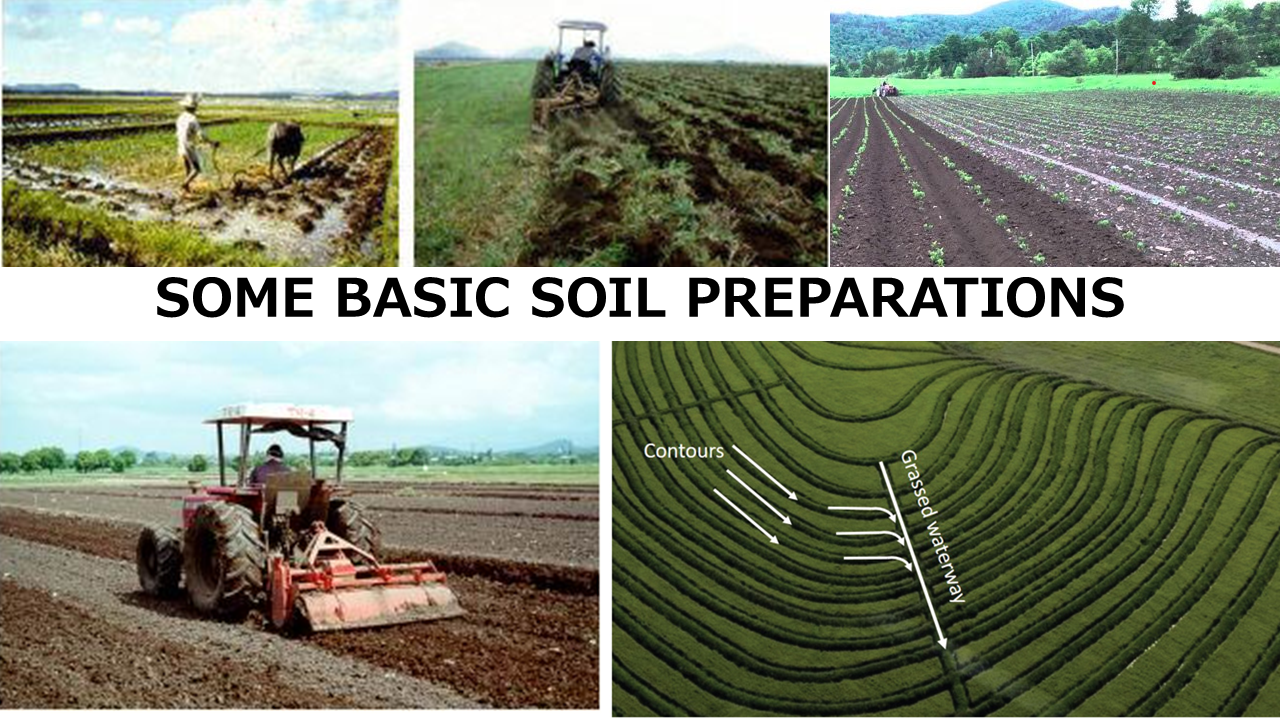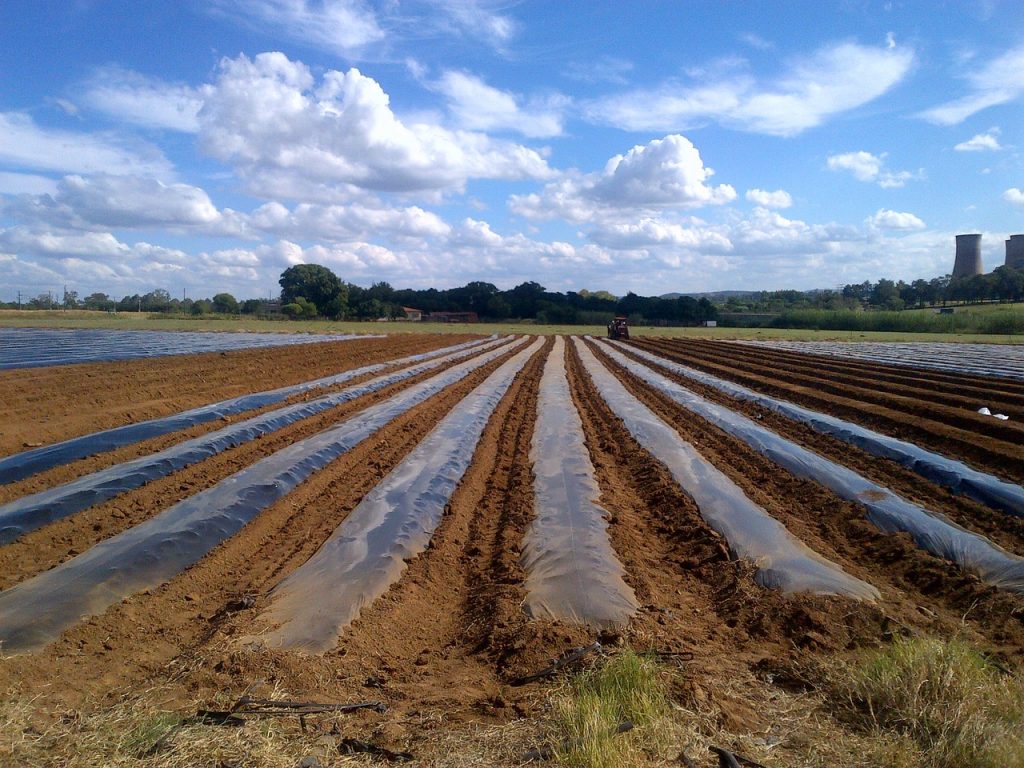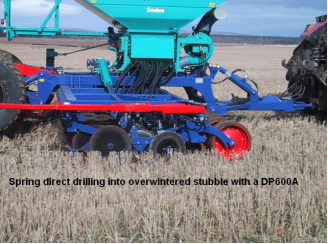Appropriate Soil Preparation Methods
Soil preparation methods are dictated by the properties of the soil profile, being stratification, texture, pH and salinity. Before soil preparation can be done effectively, a soil survey is required. Some basic soil preparations include:
- Primary cultivation
- Secondary cultivation
- Ridging
- Levelling and contouring

Vegetable and field crops may require seedbed preparation as the most important step in the soil preparation process. A good seedbed is characterized as being fine, firm and level. This is to ensure good contact between the seed and the moist soil in order to facilitate germination and rapid adaptation to field conditions.
To obtain a fine, firm and level seedbed, primary and secondary cultivation is used. Primary cultivation is the first ground-breaking of the season which cuts and shatter the soil with relatively deep penetrating tools (15 to 30 cm). The primary cultivation leaves a rough surface texture. Ploughs (mouldboard or shear ploughs); listers, bedders and rotary tillers are used to mix the soil with plant rests which may still be on the soil surface, lime and other chemicals which need to be applied before plant.
Primary Cultivation And Ripping
Sometimes, repetitive primary tillage can cause compaction layers (15 to 30 cm below soil surface), which prevents root penetration, encourages runoff and waterlogging. To break up such compaction layers, rippers are used. It loosens the soil by lifting the soil and letting it down without any mixing, in an up-and-down motion.
These implements can penetrate the soil to a depth of up to 90 cm. The principle of this method is to loosen the soil without changing the downwards sequence, or layering. The best loosening is achieved by ripping the soil in two directions, of which the deepest is down-slope. The angle between the two directions should be 60°. To improve the lifting action, wings are attached to the ripper-tine at an angle of 30° with the horizontal at operating depth. This preparation method is also suitable for soils with clayey, acid, saline or carbonate-rich subsoil. Under these conditions, the subsoil must never be brought to the surface. Due to the cost involved when the soil is ripped, other primary cultivation actions will often not be done after ripping.
Secondary Cultivation
Secondary cultivation follows primary cultivation or ripping. This involves operations, which pulverize level and firm the top 5 to 15 cm of soil. It leaves the soil with a crumbly top layer of soil 2 to 3 cm on top of a firm, but not "hard-panned," subsoil. The loose top layer is necessary for oxygen supply and temperature regulation for seed germination and root growth as explained earlier. Implements used during secondary cultivation include disk harrows, cultivators and rotary tillers.
Ridging the Soil
Inter-row Spacing
The spacing between cropped rows differs between crops. In the case of citrus trees, inter-row spacing may vary from 5 to 7 metres. The space required for spray machines and other orchard vehicles is 2.5 metres.
Citrus
When the depth of suitable soil is limited, the soil from the inter-row spaces can be moved to the area where the trees will be planted, thus excavating the vehicle paths and filling the planting area with more suitable soil. This creates ridges of suitable soil.
The purpose and advantages of ridging are:
- Improvement in surface drainage.
- Increase in soil temperature in the upper layers.
- Increase in the depth of suitable soil.
- Savings in fertilizer and energy cost.
- Facilitation of the mixing of fertilizers.
- Control of vehicle movement in the orchard. Ridges clearly indicate the inter-row paths and re-compaction of the soil is limited.
Before ridging, the required lime, gypsum or phosphates are mixed with the top 20 to 30 cm soil layer. The ridges are then built with soil containing the right amounts of nutrients. The mixing process is more effective and cheaper when this method is used, while also saving on fertilizer costs.
The height of the ridge is determined by the thickness of the suitable layer of soil. If this layer is less than 20 cm thick, ridging will not improve the potential of the soil sufficiently, although it also depends on the layer below this suitable layer.
The disadvantages of ridging are:
- Higher soil temperature, which can be up to 5°C higher compared to a flat soil surface.
- Increased evaporation of water.
- Limitation in irrigation design, as only drip and micro-jets, can be used.
- The undulating surface makes picking more difficult.
Other Crops
Ridges are often used in the production of vegetables and field crops to improve drainage and aeration. To ensure the benefits of ridging, the ridges should be at least 30 cm above the normal soil surface. The width of the ridges will depend on the number of rows planted per ridge and the amount of space needed by individual plants, and can therefore be as wide as 1 meter, as but seldom more than that.
In most crops, the soil is only ridged once during the life span of the crop. In potatoes, however, it is often done twice. First before the plant and the second time after the plants have reached a height of 30 to 50 cm. The bottom 20 cm of the plant is then covered with soil coming from between the rows. In this case ridging (also called earth up) is done to cover the tubers, and protect the tubers against attacks from the potato tuber moth and some tuber diseases. By covering the tubers with soil, also prevents sunlight from coming in contact with the tubers. If tubers are left in direct sunlight, they will turn green. Green tubers do not taste nice, and if one consumes too many green tubers at one go, you may become ill. Additional benefits of ridging at this stage are reducing the soil temperature around the developing tubers and physically controlling weeds growing between the rows. Special ridge-making implements are available for use in potatoes and one should enquire about this from your local implement dealer.
Levelling and Contouring
This involves the shaping of the soil surface within a field to improve surface drainage and eliminate areas where water may pond. The activity requires the use of cultivation and land levelling equipment such as scrapers and heavy tractors. Land grading is generally used to improve drainage but can be used to change the aspect of a site, remove bumps and hollows or provide improved erosion control. See Session 1 of this unit standard for more information on sloping and the handling thereof.
Mulching
In areas where water (erosion and losses) are problematic, a layer of plant rests (mulch) are often placed on the soil surface. This layer prevents excessive water losses through evaporation and runoff. Mulching is one type of conservation tillage and the requirement for this is that at least 30% of the soil surface be covered by mulch. The mulch can be from in situ plant rests or applied to the field from other sources.
Mulching can, however, not be recommended where there is a problem with soil-borne diseases. The mulch will in this case provide a habitat for the diseases to flourish in and this will be detrimental to the crop.

Minimum and Zero Tillage
Minimum and zero tillage are also forms of conservation tillage. These types of tillage practices imply that there will be minimum or no soil disturbance.
With minimum tillage, only that part of the soil that will be planted to the crop will be disturbed. The disruption of the soil often includes a loosing of the topsoil in the planter furrow, followed by sowing of the seed in the cultivated furrow. The previous season’s plant rest is often disked into smaller units to form a mulch layer on the soil surface (Fig 4.1.).
Figure 4.1. Seed drilling (sowing) in minimum tilled soil, covered in the wheat mulch.
In zero tillage practices, the soil will only be disturbed by the drilling of a hole in which the seedling or seed is then placed. The plant rests of the previous season will often still be in place on the field (Fig 4.2.). It is therefore not incorporated into the soil, nor disked into smaller units.

Figure 4.2. Seed drilling (sowing) in a zero tilled soil, covered by the stubble of the previous season’s wheat.
